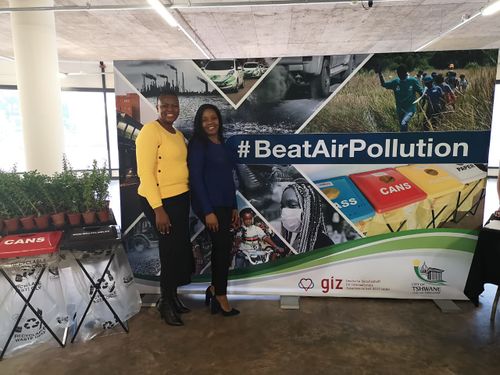Click here to register!
Air Quality Management And Greenhouse Gas Emissions Reductions
Approximately 6 million premature deaths occur annually due to air pollution, making it a major global health risk and top priority for international as well as national health and environmental politics. The main culprit for those deaths are small particles, especially particulate matter with a diameter of 10 μm (PM10) or even the smaller particulate matter with diameter of 2.5 μm (PM2.5). PM2.5 consists of different ingredients, with one of the most important ones being black carbon (BC). 55-65% of anthropogenic BC emissions are generated mainly by industry and transport through the incomplete burning of fossil fuels. BC is a Short Lived Climate Pollutant (SLCP). Besides BC, the most common SLCPs are hydrofluorocarbons (HFCs), tropospheric ozone (O3) and methane (CH4). SLCPs are responsible for approx. 40% of global warming[1]. They not only contribute to global warming and cause premature deaths, but also promote chronic diseases, e.g. acute respiratory infections or chronic obstructive pulmonary disease. Premature birth most likely is also related to air pollution[2], and it can hinder the effectiveness of antibiotics and medication[3]. SLCPs also damage plants, reducing their photosynthesis and CO2 absorption capacity, exacerbating hereby global warming and affecting agricultural yields. Reducing SLCPs therefore has positive effects on public health and on global warming alike. Reducing CH4 and BC alone can lower global warming by approx. 0.5°C until 2050[4]. Yet, since SLCPs are short lived in the atmosphere, their reduction has to go hand in hand with CO2 reduction to have lasting effect. Luckily, some strategies to reduce SLCPs serve also to reduce CO2 levels, e.g. regulations on fuel, phasing out coal burning etc.
Air Pollution in Lower and Middle Income Countries
Especially affected by air pollution are Lower and Middle Income Countries (LMIC). According to the World Bank, about 95% of adults and children impacted by pollution-related illnesses live in those countries. Those numbers show two things: the urgency to proactively address air pollution and the inability to do it effectively until now. Political arrangements, institutional settings, funds to tackle air pollution and greenhouse gas (GHG) emissions as well as knowledge about the impact of air pollution, its relation with GHG emissions and ways to counter it are insufficient and have to be addressed in most of those countries. This is due both to insufficient capacities as well as political will. While generally PM10 -as one of the causes of deaths and illnesses due to air pollution- is considered in many countries' legal frameworks, the even more harmful PM2.5 is not. In other LMICs' national air quality standards, related regulations and monitoring systems are missing altogether. The World Health Organization (WHO) stated in 2016: "In general, urban air pollution levels were lowest in high-income countries, with lower levels most prevalent in Europe, the Americas, and the Western Pacific Region. The highest urban air pollution levels were experienced in low- and middle-income countries with annual mean levels often exceeding 5-10 times WHO limits, followed by low-income cities. In the African Region, urban air pollution data remain relatively sparse, however available data revealed particulate matter (PM) levels above the median[5].
The project “Integrated Air Quality Management and Climate Change Mitigation”
Only an integrated framework that tackles air pollution in the wider context of GHG emissions will be effective in the long term. Erecting moss walls, greening a city or implementing filter solutions to factories or vehicles, while all somehow effective and desirable, do not have the same profound effect like avoiding the pollution in the first place. An air quality management (AQM) plan that considers air pollution as climate related will therefore usually be better suited to improve air quality.
The project "Integrated Air Quality Management and Climate Change Mitigation", funded by the German Federal Ministry for the Environment, Nature Conservation and Nuclear Safety (BMU) and implemented by GIZ strives to bring about integrated planning as well as effective short term actions on air pollution and GHG emissions reduction. The project exemplarily works in three megacities: Pretoria (Tshwane) and Johannesburg in South Africa, and Hanoi in Vietnam. Each one is struggling with major air pollution. The project assists the administrations of the three cities in implementing effective AQM plans and concrete measures, which should lead to the improvement of their air quality.
The City of Tshwane in South Africa
The City of Tshwane in South Africa has a dedicated AQM unit. GIZ currently assists them in the review of their AQM plan, a document that is valid for five years, ideally guiding during that time all the efforts the city undertakes to improve its air. And this is Tshwane's vision: "Ambient air in the City of Tshwane is clean and healthy for all citizens through effective and collaborative management that ensures compliance and sustainable development".
While there may be divergent views on what "sustainable development" exactly means, a "clean and healthy air is clearly defined as an ambient air quality that complies with the health-based National Ambient Air Quality Standards (NAAQS)". Thus, the guiding framework for any activity or policy on air quality is NAAQS. In order to put South African air quality standards into perspective, it is worth comparing them with WHO and European guidelines.
Standards: Comparison of South African NAAQS and WHO standards
Strategies to Improve Air Quality
Further Information
References
- ↑ Cf. http://www.igsd.org/documents/PrimeronShort-LivedClimatePollutants.pdf or http://www.iass-potsdam.de/sites/default/files/files/kurzlebige_klimawirksame_schadstoffe_0.pdf
- ↑ https://www.theguardian.com/cities/2017/feb/16/premature-births-air-pollution-maternal-health-who-study
- ↑ https://www.iol.co.za/mercury/environment/air-pollution-study-shock-8791974
- ↑ http://www.iass-potsdam.de/sites/default/files/files/kurzlebige_klimawirksame_schadstoffe.pdf
- ↑ http://www.who.int/mediacentre/news/releases/2016/air-pollution-rising/en/




















